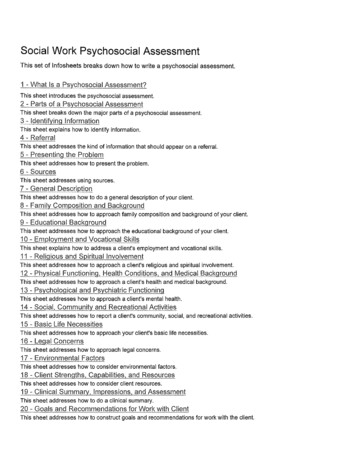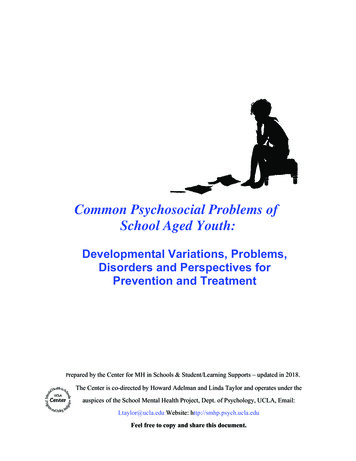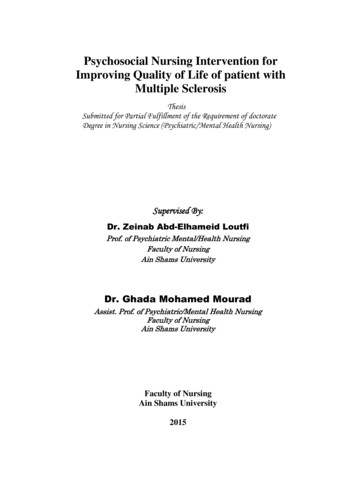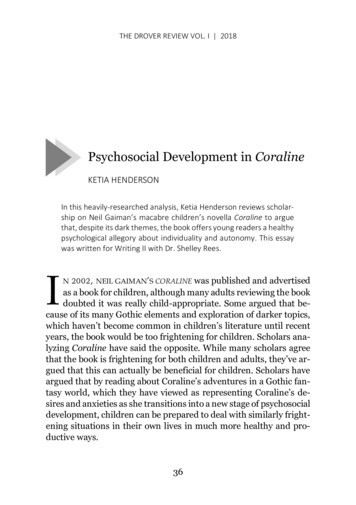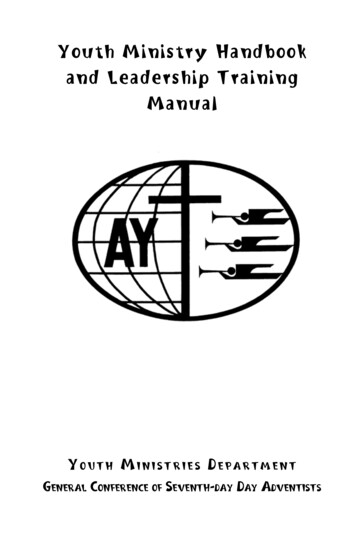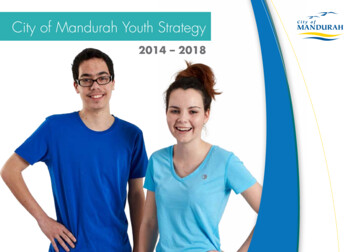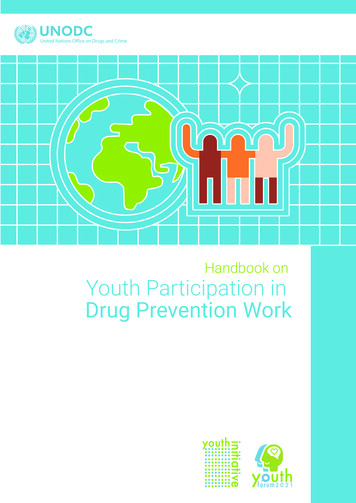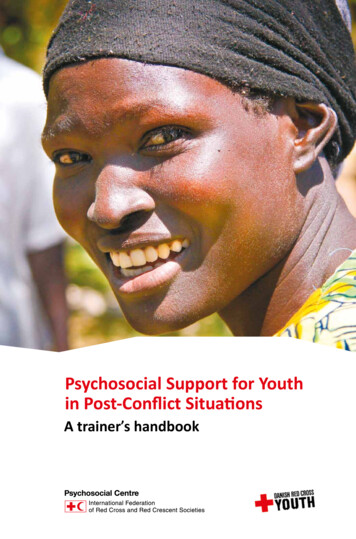
Transcription
Psychosocial Support for Youthin Post-Conflict SituationsA trainer’s handbook
Psychosocial Support for Youthin Post-Conflict SituationsA trainer’s handbook
Psychosocial Support for Youth in Post-Conflict Situations: A trainer’s handbookIFRC Reference Centre forPsychosocial Supportc/o Danish Red CrossBlegdamsvej 27,DK-2100 Copenhagen ØDenmarkPhone: 45 35 25 92 00Mail: psychosocial.center@ifrc.orgWeb site: www.pscentre.orgDanish Red Cross YouthHejrevej 30, 2.DK-2400 København NVDenmarkPhone: 45 35 37 25 55Mail: info@urk.dkWeb site: www.urk.dk/hvem-er-vi/in-englishThe IFRC PS Centre is hosted by Danish Red Cross.Warm thanks to Uganda Red Cross Society, Liberian Red Cross Society and South Sudan Red CrossSociety for their input, field tests and feedback, and to Civil Society in Development (CISU) for fundingthe project.Front cover photo: Danish Red Cross Youth.Design and production: Paramedia 1679.Printed in Denmark 2014.ISBN 978-87-92490-14-8 Danish Red Cross Youth and International Federation of Red Cross and Red Crescent SocietiesReference Centre for Psychosocial Support.Please contact the IFRC PS Centre if you wish to translate or adapt any part of Psychosocial Supportfor Youth in Post-Conflict Situations: A trainer’s handbook.Other IFRC PS Centre publications:- Community-based Psychosocial Support: A training kit- Psychosocial Interventions: A handbook- Caring for Volunteers: A psychosocial support toolkit- Children’s Resilience Programme: Psychosocial support in and out of schools- Lay Counselling: A trainer’s manual- Life Skills – Skills for Life: A handbookThe above materials can be downloaded from the IFRC PS Centre website.Other materials produced by Danish Red Cross Youth:- Volunteer Handbook: A guide to life skills activities- Life Planning Skills: A psychosocial annex for youth affected by conflict and war- Volunteer Handbook: Implementing Sports Activities for Vulnerable Children and Youth
ForewordEvery year, hundreds of thousands of young people around the world experience violentconflicts first hand. Violent conflicts interfere with youth development by disruptingeveryday life, not only while the conflict is on-going, but also after the grenades and gunshotshave fallen silent. Growing up surrounded by conflict and living in a post-conflict setting willhave enormous impact on the lives of young people and their prospects as they grow intoadulthood.Over the years, Red Cross and Red Crescent staff and volunteers have provided support toyoung people in post-conflict situations through psychosocial activities. Providing this kindof help to vulnerable people can take many forms and requires trained staff and volunteers.Psychosocial Support for Youth in Post-Conflict Situations: A trainer’s handbook is a jointinitiative of the Reference Centre for Psychosocial Support of the International Federation ofRed Cross and Red Crescent Societies (the PS Centre) and Danish Red Cross Youth. It uniquelycombines a training programme in community-based psychosocial support for youth inpost-conflict situations together with modules on facilitating training. The materials havebeen designed to develop staff and volunteers’ skills, either as a basic training in psychosocialsupport or as a training of trainers in psychosocial support.The training can be delivered as a separate package or it can be included as a componentof existing programmes, for example, in disaster preparedness, first aid or social welfare.Wherever it is delivered, this type of training seeks both to strengthen the quality of care forbeneficiaries and to provide sound support for staff and volunteers.Psychosocial Support for Youth in Post-Conflict Situations: A trainer’s handbook draws onthe extensive range of psychosocial materials produced by the PS Centre as well as on the latestresearch on youth and youth development. Additional input, case studies and feedback fromUganda Red Cross Society, Liberian Red Cross Society and South Sudan Red Cross Societyhave also been included based upon the field test conducted in the respective NationalSocieties.We hope it will be a useful tool for the Red Cross and Red Crescent Movement, as well as forother stakeholders in the field of psychosocial support.
ContentIntroductionConsequences of armed conflictsand psychosocial supportYouth in post-conflict situationsFacilitating trainings for youthin post-conflict situationsSupportive communicationSupporting volunteersPlanning and facilitatinga training workshopAnnexes912345617334751616973
Ricci Shryock/ICRC
Introduction9The Psychosocial Centre and theDanish Red Cross YouthThe PS Centre works in partnership withother services of the Red Cross Red CrescentMovement in order to serve the psychosocialneeds of individuals and communities. ThePS Centre has a large database of psychosocial support publications, which is accessiblefrom our website at www.pscentre.org. Wealso have a wide range of other materials including resources on setting up psychosocialprogrammes. For new ideas and the latestin psychosocial support, you are welcometo subscribe to our magazine Coping withCrisis, which is published three times a year,our Facebook page (IFRC Reference Centrefor Psychosocial Support), and PS News, ourmonthly e-newsletter.The Danish Red Cross Youth (DRCY) hasmany years of experience implementingpsychosocial projects for vulnerable youthtogether with local Red Cross and RedCrescent societies in Africa and the MiddleEast. Using a peer-to-peer approach, DRCYvolunteers are working to build local youngvolunteer capacity to facilitate life skills andpsychosocial activities for vulnerable youth.The activities implemented are primarilysports and games, forum theatre, music andsinging. DRCY is consistently working onimproving methods and materials that arebeing used in our projects. For more information, please visit our website at www.urk.dk/hvem-er-vi/in-english.Aims of the training programmeThe training programme aims to providestaff and volunteers with an understandingof youth in post-conflict situations, as well asbuilding capacity in facilitating psychosocialsupport training.The training programme consists of sixmodules. The first module aims to providethe participants with an understanding ofthe basic principles of psychosocial supportand reactions to armed conflicts. The secondmodule focuses on the concept of youthand on psychosocial support programmesfor youth in post-conflict situations. Thethird module aims to train the participants’facilitation techniques. The fourth moduleaims to develop supportive communication skills. The fifth module focuses onsupporting volunteers to be able to care forcolleagues and themselves. The aim of thesixth module is to provide the participantswith the opportunity to plan and facilitate atraining workshop in psychosocial supportfor youth reflecting the needs of their localcommunity.Audience: Who is this handbookfor?This training handbook is designed fortrainers, staff and volunteers in psychosocialsupport for youth in post-conflict situations.The training programme outlined in thishandbook can be used in two ways – eitheras a Training of Trainers (ToT), or as a basictraining.
010Introduction1. Training of TrainersThe ToT in psychosocial support for youth inpost-conflict situations provides participantswith an understanding of basic concepts,terminology and skills required to trainother people (usually volunteers who workin the field) in psychosocial support. TheToT also empowers participants to deal withsensitive issues and provide reassurance aswell as emotional support.The trainer of a ToT should preferably have abackground in health, mental health, socialwelfare, education or conflict studies, orhave a good understanding of social work,psychology and youth in post-conflict situations. Additionally, good communicationskills and knowledge of facilitating trainingsfor adults are essential.The ToT in psychosocial support for youth inpost-conflict situations will enable participants to: facilitate trainings for other volunteers understand psychological and social reactions, needs and interventions, respectingrelevant and appropriate cultural frameworks plan a variety of interventions that aresensitive to local circumstances plan a training workshop, and adapt materials to the local context.The ideal number of participants for a ToTworkshop is between 12 and 18. NationalSocieties are advised to recruit participantswho have an opportunity to train others inthe community, in order for the training toachieve maximum effect. The ToT can bestructured in different ways, based on theneeds of the National Society. However, werecommend that a ToT be completed in noless than five days and that it include modules one through six.2. Basic trainingThis training aims to provide a basic introduction to psychosocial support and facilitation techniques. Participants may come froma variety of backgrounds, not necessarily ahealth, mental health or social welfare background. The length of this training can varydepending on the needs of participants andthe request for training. It should includemodules one through five. The preferredmaximum number of participants per training is 18.The person conducting basic training shouldhave completed the ToT.The basic training will enable participants to: become familiar with psychological andsocial reactions, needs and interventions,respecting relevant and appropriate cultural frameworks plan and implement a variety of interventions sensitive to local circumstances undertake psychosocial activities for vulnerable youth.The psychosocial trainerA psychosocial support trainer should ideally possess the following knowledge andskills: knowledge of the the Red Cross Red Crescent Movement knowledge of youth in post-conflict situations and working conditions in the field training and facilitation skills skills and experience in supporting others.It is important that the trainer is well prepared and feels comfortable with the topicsthat are to be covered in the training. As apsychosocial trainer, it is important to ‘walkthe talk.’ This means that the trainer should: trust and believe in the abilities of youngpeople listen to participants and understandwithout interrupting, evaluating or judging what is being said manage group processes in a non-discriminating way communicate in a constructive and respectful manner, being aware of appropriate language, posture, gesture and facialexpressions be flexible and responsive, adapting activities when needed protect minority points of view keep the discussion moving, limiting eachindividual contribution to make time foreveryone be sensitive to unexpressed feelings be empathic
Introduction allow participants to make their owndecisions and not make decisions on theirbehalf be prepared to take part in activities whenneeded.If a National Society is not able to identifya local trainer, the PS Centre can provideassistance with finding a trainer and can giveadvice on training programmes.Using the handbookPeople differ in how they assimilate information. Visual presentations, interactiveexercises and short teaching slots will allhelp in meeting different learning styles.The handbook features various trainingmethods and ways of reviewing the materials that help maintain participants’ interestand integrate learning.Each module has trainer’s notes, togetherwith PowerPoint slides and teaching materials on each topic. The trainer’s notes for eachmodule include: learning objectives which constitute theoverall aims of the module an introduction, so that the trainer canset the scene, introducing the topic andmotivating participants for the learningprocess notes about the topic with accompanyingPowerPoint slides plus fact boxes with additional information instructions for activities and group exercises that correspond to the objectives ofthe module a recap activity at the end of the module.The trainer’s notes feature specific activitiesfor each module. The activities are designedto help participants understand the relevance of the training in relation to their ownsituations. They are also aimed at broadening participants’ view of their work throughinteraction with other group members.The trainer’s notes also contain suggestionsfor discussions with participants. Discussion questions are directed at participants’experiences to stimulate reflection andawareness. The intention is for participantsto share experiences rather than come upwith predetermined conclusions. Accordingto the needs and interests of each group, different discussion questions from those listedin the trainer’s book can be used.Each module can stand alone or be incorporated as part of a longer workshop with several modules. Training should be adapted tolocal settings, using case studies, scenariosand pictures that are relevant to the context.All the activities, group work and teachingmaterials will therefore need to be adaptedaccordingly.There is an example of a workshop planner in Annex 6. It outlines how a trainingworkshop in psychosocial support for youthin post-conflict might be organized. Pleasenote that this is simply a suggestion illustrating how to structure the programme. Trainers will need to plan their own workshopspecific to the needs, knowledge and skills ofthe staff and volunteers they will be workingwith.Instructions to trainers are given in italics.So that trainers may easily adapt the training according to participants’ needs, thePowerPoint slides attached to the manual asa teaching tool can be edited to suit the localcontext. Prepared PowerPoint slides as wellas a template (should trainers wish to createtheir own slides) are available for downloadon www.pscentre.org.The training contextTraining needs to be planned together withother interventions designed to strengthenyouth in post-conflict situations. The eventshould not be a “one-off,” and follow-up isimportant. Some things to consider whenplanning a training include: Why does the branch office want thistraining, and why now? Who are the likelyparticipants and how will they use theirnew skills? How should the training be structured?Should it be one workshop (delivered inone day, for example) or several sessions(for example, delivered once a week for amonth)?011
012Introduction How will the training be followed up? Isthere somebody in the National Society orbranch office who will be responsible fordirecting the staff and volunteers’ newlygained skills toward any programmes orprojects? If the training is a ToT, have future trainersagreed and set time aside to conduct training of others? How will these trainings beorganized? Who will participate? Can any additional or refresher courses beplanned?The training should also be adapted to thespecific geographic and cultural context. Thetrainer must have a thorough knowledge ofthe material in this handbook. They shouldalso know something about psychosocialneeds and programmes in the society orregion where the training takes place.To make the training even more specific tothe group, trainers should draw on their ownexperiences and that of colleagues and localnetworks. Using examples of good practicein psychosocial support projects and indicating the need for psychosocial support programmes will also help participants to applyactivities and discussions to their work.Evaluation and endingsEvaluation of the training programmeprovides the trainer with feedback, clarifying whether objectives were realistic andexpectations achievable. Feedback contributes to the quality of the training over timeby giving the participants an opportunityto express whether some modules or topicsneeded further clarification. It is also an aidto the trainer’s professional development.An example of an evaluation questionnaireis included in Annex 4. This can be used togain an overview of how participants foundthe training. A questionnaire is useful, butthere is also a case for getting more immediate and personal feedback through an evaluation session with the training group.Questions that participants might address ina group evaluation discussion include: To what extent has your knowledge ofpsychosocial support and youth in postconflict increased? To what extent has the workshop met yourexpectations? To what extent were the goals of the workshop achieved? How accessible were course materials?What was particularly useful? Were thereany difficulties? What were you particularly pleased withduring the course? What suggestions do you have for improving the course? What were the three most importantthings that you learned? What was the most significant experiencethat you had during the training?A good relationship with participants allows the trainer to ask for comments and toencourage constructive criticism. Rememberthat constructive criticism indicates thatthe learning environment is safe. It can helptrainers adjust the training methods andstrengthen their own skills.At the end of the training, it is customary topresent participants with certificates, indicating the type of training completed, i.e. abasic training, a ToT, or a more specializedkind of training. Certificates also state whichmodules have been covered and the lengthof the training workshop.Having spent up to five days together, it islikely that participants will feel a bond withone another. Trainers can circulate a contactlist to participants, if they consent to theirdetails being shared. This enables the groupto keep in touch with one another after thetraining is over.
Welcome, ground rules andintroduction to the training workshopIntroductionThe first day is essential to the success ofthe workshop. It is important to start on apositive note. The participants need to getcomfortable with their surroundings andhave time to get to know each other and thetrainer, since the topics of the training canbe personally sensitive for some participants.If this is in place, participants will have thechance to develop trusting working relationships, increasing their confidence in sharingpersonal and sensitive information duringthe course. It is therefore desirable to usefirst names if this is customary. Make surethat nametags for participants are availableand that all the materials that participantsneed are ready for day 1 (including a training programme, hand-outs, notepaper andpens) and that you have everything you need(e.g. trainer’s notes, PowerPoint slides andprojector, flipchart paper and markers, etc.).PPT 0.1: IntroductionWelcomeStart by welcoming the participants to theworkshop. Explain that in this first part ofthe workshop, everyone will get to know oneanother and begin to work together on theground rules for the whole workshop. Explainthat you will give an overview of the workshop.Ice-breakerOne way to make the participants comfortable with each other is by facilitating anice-breaker (see Annex 1), for example, theball toss:1. Form a circle with participants, and toss asoft ball to someone in the circle.2. As that person catches the ball, ask themto say their name, one expectation for thetraining and something special about themselves as a person.3. Include yourself as the trainer in this activity so that participants get to know you aswell.This activity can be used throughout theworkshop to reinforce learning on a topic.Instead of asking participants to say theirname, they can respond to a particularquestion. For example, if you have done thesection in module 5 on signs of stress, youcan ask participants to shout out examplesof signs of stress as they catch the ball.13
0IntroductionGround rules14Establish some ground rules for the training.PPT 0.2: Ground rules Make an agreement with the group aboutparticipants needing to leave the room (forexample, to use the bathroom or to answerthe phone for an urgent work call). Workout how this can be done with minimaldisruption to everyone. If a participantis in the middle of a personal story, itcan be very frustrating to be interruptedby a ringing phone. This might result infeelings of uneasiness. It may also be seenas disrespectful to leave the room whensomeone is sharing their experiences withthe group.The training programme1. Ask participants to work together ingroups of two on ground rules for the training. Give them five minutes to do this.2. Share in plenary what each pair has comeup with.3. As each pair reads out their suggestions,write them up on a flipchart. You can alsoadd your own expectations. You can includethe following points: Let participants know that they are invitedto share their experiences and skills andthat this is valuable. Encourage participants to ask questionswhenever they are confused or do notunderstand something. Let participants know that feedback ishelpful to everyone in the group. Confidentiality: In a workshop like this,building trust is essential. Lots of personalstories will be shared, and participants mayexpose themselves emotionally. It is important to agree that everything that is sharedwithin the group will remain confidential.Everybody who can agree to this nonnegotiable rule should raise their hand. Ifsomeone does not agree, they should nottake part in the training, (you should ofcourse ask why they do not agree). Ask the participants to turn off theirmobile phones. If this is not possible, askthem to put them on silent mode out ofrespect for each other. Emphasize punctuality. Let participantsknow that the workshop will start andend on time as long as everyone returnspromptly from breaks and lunch.Give an overview of the training programmeand indicate where participants can find theinformation in their training materials.PPT 0.3: Training programmeThe training consists of six modules: Module 1 introduces the basic principlesof psychosocial support and reactions toarmed conflicts. Module 2 focuses on the concept of youthand on psychosocial support programmesfor youth in post-conflict situations. Module 3 provides an opportunity to practise facilitating training. Module 4 focuses on supportive communication skills. Module 5 looks at supporting volunteers,so that they can care for their colleaguesand themselves. Module 6 is an opportunity to plan a training workshop in psychosocial support foryouth reflecting the needs of their localcommunity.
Jacob Pedersen16module
Consequences of armed conflictsand psychosocial support171.1 IntroductionThis module defines psychosocial supportand the psychosocial consequences of armedconflicts. It explains how support is given atdifferent levels across the community. It is afoundation for the rest of the training and istherefore very important to take time withparticipants to ensure that they understandthe material.PPT 1.2: Learning objectivesPPT 1.1: Module 1: Consequences of armed conflictsand psychosocial support1.2 What is psychosocial support?PPT 1.3: Psychosocial supportBegin by introducing the module and highlighting the learning objectives.At the end of the module, participantsshould be able to understand: what psychosocial support is how to respond to different needs how armed conflicts affect psychosocialwell-being.
1Consequences of armed conflicts and psychosocial supportActivity 1.1: Plenary18(20 minutes)PurposeTo have participants think about psychosocialsupport and what it meansMaterials requiredFlipchart paper and markersProcedureExplain the purpose of the activity to participants. Invite participants to answer thediscussion questions below. As they respond,record what they say on flipchart paper.Discussion questionWhat is psychosocial support?PPT 1.3: Psychosocial supportPPT 1.4: What is psychosocial support?The psychosocial support approach is acommunity-based approach provided mostlyby volunteers. Red Cross Red Crescent staffand volunteers are usually part of the localcommunity; therefore their support canreach large groups of people and can reflectcommunity needs.Working at the community level insteadof an individual level is an effective way ofsupporting a large number of people. In thisway, psychosocial support reinforces socialnetworks or restores them, if they are notintact. It helps people learn how to protectthemselves and others, thereby engagingthem in their own recovery. It is importantto involve the community in the planningand implementation of specific psychosocialactivities. This protects the interests andconcerns of those affected.Psychosocial support is the process of facilitating resilience within individuals, familiesand communities. Through respecting theindependence, dignity and coping mechanisms of individuals and communities, psychosocial support promotes the restorationof social cohesion.The term ‘psychosocial’ refers to the dynamic relationship between the psychological and social dimensions of a person’s life.The two dimensions influence one anotherand are very closely linked. They can bedescribed as follows: Psychological dimension: internal, emotional and thought processes, feelings andreactions Social dimension: relationships, familyand community networks, social valuesand cultural practices.The Red Cross and Red Crescent Movementsometimes delivers psychosocial supportthrough programmes specifically designedto address psychosocial issues. However, itis more common that psychosocial supportis integrated within other activities and inprogrammes such as health or education.What is ‘psychosocial’?The term ‘psychosocial’ reflects somethingall people share. As human beings, we allhave feelings and thoughts that affect howwe react to life situations and how we relateto others – in both positive and negativeways. Recognizing that stress can affectour feelings, thoughts, physical health andrelationships is the basis for psychosocialsupport and well-being. When we are underspecial stress, such as the stress of workingin emergencies, we need to pay more attention to our psychosocial health, as well as topsychosocial support for ourselves and eachother.Psychosocial support refers to the actionsthat address both the psychological andsocial needs of individuals, families andcommunities.
Consequences of armed conflicts and psychosocial support1.3 Why provide psychosocialsupport?PPT 1.5: Why provide psychosocial support?Psychosocial support activities can involveefforts to protect women, children and othergroups particularly at risk from violenceand exploitation. However, all psychosocialactivities aim to promote resilience by establishing the following five elements:1. Sense of safety2. Calm3. Sense of self- and community4. Connectedness5. HopeActivity 1.2: BuzzingPsychosocial support can be provided tofacilitate: Resilience: the ability to bounce backafter something difficult has happened,or to get through difficult experiences in apositive way Coping mechanisms: the ways peopledeal with challenges and difficult situations Restoration of social cohesion: reinforcement and strengthening of socialnetworks and structures.ResilienceResilience is described as a person’s or acommunity’s ability to absorb shock andbounce back after experiencing a critical ortraumatic event. Resilience does not meanthat people do not experience distress fromthe events in their lives, but rather that theyare able to cope with and recover from themusing their resources.1.4 Psychosocial activitiesPPT 1.6: Psychosocial activities(15 minutes)PurposeTo let participants think about psychosocialactivitiesProcedureAsk the participants to spend 10 minutesbrainstorming psychosocial activities. Followup in plenary.QuestionWhat psychosocial activities can you think of?PPT 1.7: BuzzingPPT 1.7: Buzzing119
1Consequences of armed conflicts and psychosocial support1.5 The intervention pyramidThis training focuses on giving participants abasic understanding of psychosocial supportactivities in the third level of communityand family supports. It enables participantsto understand psychological and social reactions, needs and interventions, respectingrelevant and appropriate cultural frameworks and to plan a variety of interventionsthat are sensitive to local circumstances. Themore specialised services for youth are notcovered in this training. However, information is given about making referrals wherethese are needed.In this section you will help participants become familiar with the intervention pyramidfor mental health and psychosocial supportin emergencies and address training needs.PPT 1.8: Intervention pyramid20Support is offered at these four levels:1. Basic services and security: People’swell-being is protected through meetingtheir basic needs and rights for security, governance, and essential services such as food,clean water, health care and shelter. A psychosocial response here might involve advocating that these basic servicesand protections are put in place and aredone in a respectful and socially appropriate way.This pyramid illustrates the different kindsof support people may need, whether intimes of crisis, at an early stage of recovery,or in the on-going situations of distressexperienced by people over many years. Psychosocial support can be given at each level.Mental health and psychosocial support servicesImpacts on population due to crisesResponses suggestedProfessional treatmentfor individuals or familiesIndividual, family orgroup interventions4321SpecialisedservicesFocused, nonspecialised supportPsychosocialsupport activitiesCommunity andfamily supportsFulfilling basicneeds, providingsecurityBasic servicesand securitySevere psychologicaldisordersMild to moderate mentalhealth disordersMild psychological distress (natural reactionsto crisis event)General populationaffected by crisisSource: This illustration is based on the intervention pyramid for mental health and psychosocial support in emergenciesin the IASC Guidelines (2007).
Consequences of armed conflicts and psychosocial support3. Focused support: A still smaller numberof people will, in addition, req
Uganda Red Cross Society, Liberian Red Cross Society and South Sudan Red Cross Society have also been included based upon the field test conducted in the respective National Societies. We hope it will be a useful tool for the Red Cross and Red Crescent Movement, as well as for
